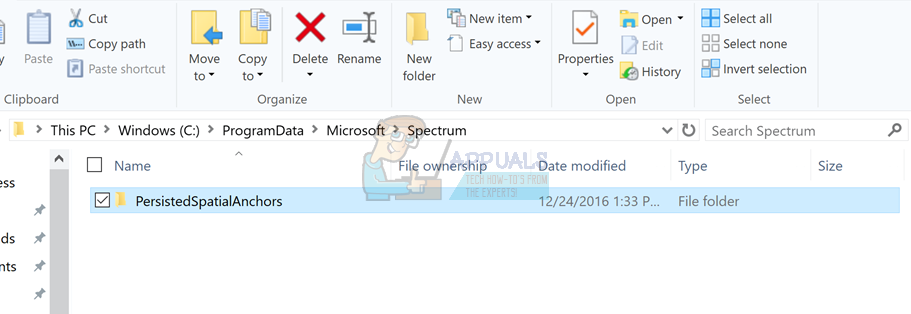This error occurs as a result of bugs present in one of the latest Windows 10 builds starting from Build 15007 and it is noticeable whenever a PC user tries to play any audio. The problem is with the Windows Spectrum program so deleting or disabling Spectrum usually fixes the issue. The Microsoft officials have already admitted that it’s a known bug and are trying to fix this bug in the latest builds. The following methods and steps should reliably fix the problem.
Method 1: Fix Audio from CMD
Method 2: Deleting Spectrum Folder
Since the problem is caused by the Windows Spectrum, deleting the Spectrum folder solves the problems caused by it.
Now restart your computer and the audio problem should be solved by now. Note: If it says that the folder or program is in use and can’t delete it then restart your computer and then try to delete it. If you still can’t delete the files after a reboot then follow method 3 to stop the Spectrum service and follow this method to delete the file.
Method 3: Stop Spectrum Service (Check this method. I couldn’t perform it because I don’t have the Spectrum. A User suggested it.)
If you aren’t comfortable by deleting the Spectrum or it doesn’t let you delete the Spectrum because it is in use then that means you have stop the Spectrum first. Or You can repeat the method 2 after this to make sure that Spectrum is deleted and it doesn’t start again. If you are connecting your audio device via USB or HDMI then you will need to set the audio device as the default device. Right click the sound icon on your screen (right bottom) and select Playback devices. Select your audio device and click on the Set Default.
Method 4: Trying Different Audio Formats
Sometimes the issue might be because of the unintentional change in the audio format. You can change the audio format back to what it originally was, very easily. But, sometimes there might be multiple audio formats available for you. In that case, you should try every audio format until your sound starts working again. These are the steps for changing your audio formats Repeat the above given steps and select some other audio format if the audio doesn’t work. You should try to select each audio format from the list to make sure the problem isn’t caused by the wrong audio format.
Method 5: Disabling and Enabling
Disabling and then re-enabling your default device from the sound screen seems to work for a lot of users. Follow the steps given below to disable and then re-enable your default device Your audio should work fine once you are done.
Method 6: Disable Enhancements
Disabling the enhancements for your audio device also solves the issue that you are having. It is a Microsoft’s recommended solution as well. If disabling enhancements doesn’t work then move to the next method.
Method 7: High Definition Audio Device Driver
Reinstalling your audio driver and selecting the High Definition Audio Device solves this problem as well. Usually, the High Definition Audio CODEC will be available (or a variation of it) which causes this problem. If High Definition Audio CODEC is already the driver in your device manager then it is a good indicator that the problem is caused by this. This has something to do with the latest Windows update and this driver. So, updating/re-installing the driver and selecting the above mentioned driver solves the problem. Once you are done, your audio should work properly.
Method 8: Update Drivers
Although this might seem unnecessary but sometimes the problem is simply associated with the wrong/corrupted audio driver. You have to make sure that you have the compatible and the latest drivers installed. You can install the drivers both automatically and manually. Steps for both are given below.
Automatic Driver Update/Installation
You can uninstall the driver and reboot your computer. The Windows will automatically search and install the most compatible audio driver for your system. Once the system is rebooted, your audio should be back. You won’t have to do anything. Or you can force the Windows to search and install a compatible driver for your system by following the steps given below.
Manual Installation
If the automatic search for drivers doesn’t work then you can always do a manual install of the drivers. Manually installing the drivers isn’t hard and takes only a few minutes. For this to work, you will need to go to your audio manufacture’s website and download the latest driver. The complete step by step guide is given below
Now follow any addition on screen instructions and reboot your computer when the driver is installed. This should fix the audio driver issue for you.
Method 9: Windows Troubleshooter
The quickest thing that can solve your problem is the Microsoft’s own Troubleshooter for sound. You can easily download it and run it. The troubleshooter will automatically detect and solve any problems you might have Go here and download the troubleshooter. Run the troubleshooter once you are done downloading it. Follow the on screen instructions to check what the problem is. You can also click on your sound icon in the tsk bar (bottom right corner) and select Troubleshoot sound problems. It will automatically detect and solve any issues that you might have.
[FIX] Spatial Sound Reverting to Windows Sonic on WindowsFix: Kodi No Sound on Windows 7, 8, and 10How to Fix ‘Spotify Randomly Lowering Sound’ on Windows 10How to Fix the NVIDIA High Definition Audio no Sound Problem on Windows?



















